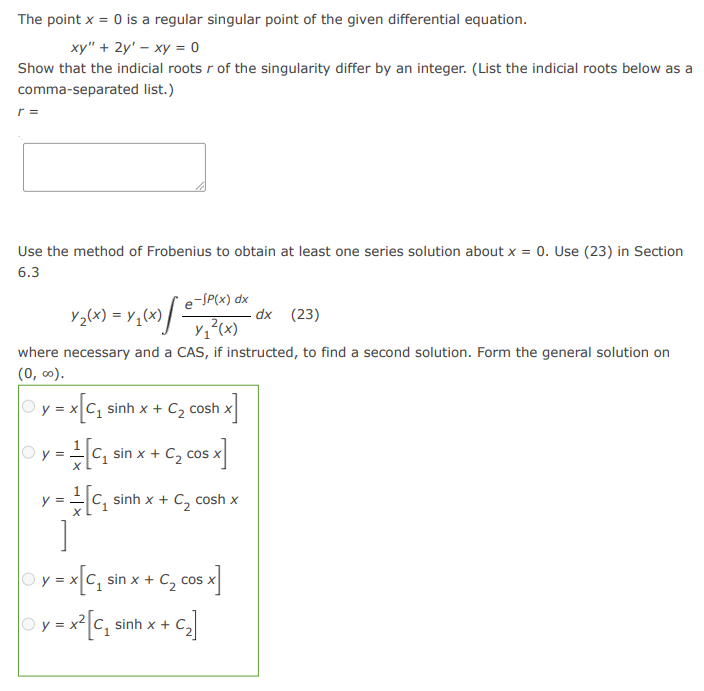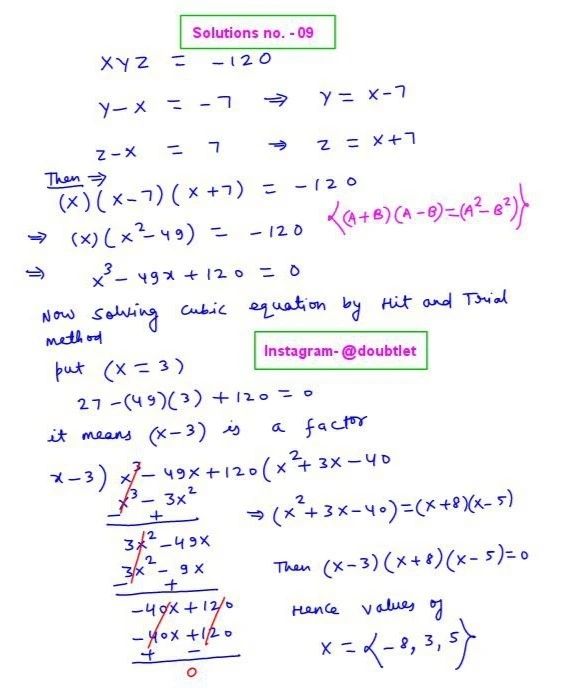









The point is a regular singular point of the given differential equation:
-
(a) Show that the indicial roots of the singularity differ by an integer. (List the indicial roots below as a comma-separated list.)
-
(b) Use the method of Frobenius to obtain at least one series solution about . Use (23) in Section 6.3:
where necessary, and use a CAS if instructed to find a second solution. Form the general solution on .
The point is a regular singular point of the given differential equation:
-
(a) Show that the indicial roots of the singularity differ by an integer. (List the indicial roots below as a comma-separated list.)
-
(b) Use the method of Frobenius to obtain at least one series solution about . Use (23) in Section 6.3:
where necessary, and use a CAS if instructed to find a second solution. Form the general solution on .
Question :
The point is a regular singular point of the given differential equation:
-
(a) show that the indicial roots of the singularity differ by an integer. (list the indicial roots below as a comma-separated list.)
-
(b) use the method of frobenius to obtain at least one series solution about . use (23) in section 6.3:
where necessary, and use a cas if instructed to find a second solution. form the general solution on .

Solution:

Neetesh Kumar | October 24, 2024
Differential Equation Homework Help
This is the solution to Math 2A, section 13Z, Fall 2023 | WebAssign
Math002ACh6Sec03 (Homework) Question - 5
Contact me if you need help with Homework, Assignments, Tutoring Sessions, or Exams for STEM subjects.
You can see our Testimonials or Vouches from here of the previous works I have done.
Step-by-step solution:
Part (a): Indicial Roots
The given differential equation is:
This is a second-order linear differential equation with a regular singular point at . We will apply the Frobenius method to find the indicial equation and the roots.
Step 1: Rewrite the Equation in Standard Form
Divide the entire equation by to obtain the standard form:
Now, compare this with the general form:
From this, we identify:
Step 2: Frobenius Method
Assume a solution of the form:
Substitute this into the differential equation and collect terms for the lowest power of . The indicial equation comes from the coefficient of the lowest power of .
After substituting into the equation and simplifying, we obtain the indicial equation:
Simplifying this equation:
Factoring:
The roots of the indicial equation are:
These roots differ by 1, confirming that the roots differ by an integer.
Thus, the indicial roots are:
Part (b): Series Solution and General Solution
We now use the Frobenius method to find the general solution. We have two roots: and . The solution for gives us the first solution, and we will use the integral formula to find the second solution for .
Step 1: First Solution
For , we substitute into the series solution and obtain:
Thus, the first solution is:
Step 2: Second Solution
To find the second solution , we use the formula:
From earlier, . So:
Therefore:
Now, substitute into the formula for :
Thus, the second solution is:
Step 3: General Solution
The general solution is a linear combination of and :
Step 4: Form of the Solution
Given the options provided in the problem, the form of the second solution and general solution fits with the third option, which is:
This option represents the general solution regarding and functions.
Final Answer:
- The indicial roots are .
- The correct form of the solution is the third option:
Please comment below if you find any error in this solution.
If this solution helps, then please share this with your friends.
Please subscribe to my Youtube channel for video solutions to similar questions.
Keep Smiling :-)
Comments(0)



Leave a comment